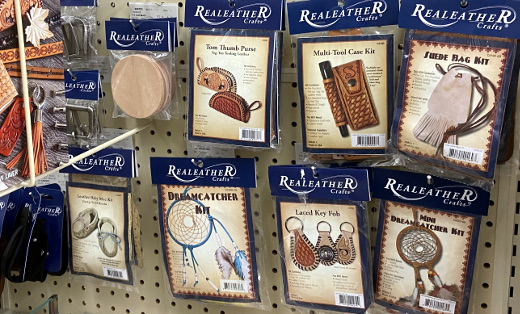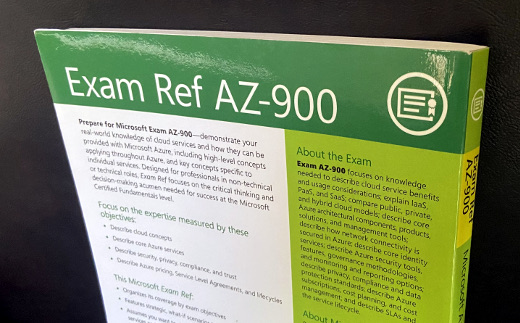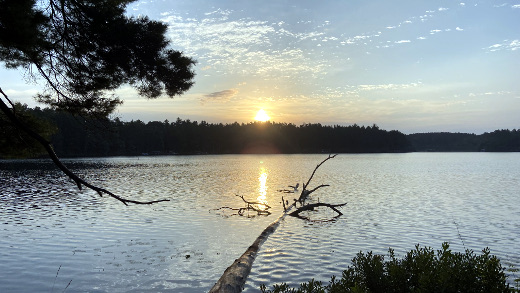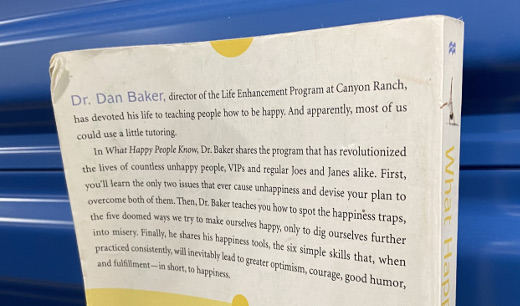Browsing What’s Possible

A recent chance visit to a retail store became the catalyst of a serendipitous journey on how I do research into my job and seek information in general.
After dropping off my mobile device to get a new battery installed, I was told it would be ready in an hour. As I don’t wear a watch and my phone is how I know what time it is, I decided to peruse some of the stores along the strip mall, inside at least one I hoped would have a clock to let me know when I could return to the repair shop. At this later hour on a Saturday the only other store open was Hobby Lobby.
I had never been in a Hobby Lobby store before, but I know people who have. Before walking in I assumed it had – wait for it – hobby supplies, but more for crafting. To my surprise I found you could do everything from plan a wedding to decorate for Christmas (ugh, in August) to design clothes to make pinewood derby care like I did in Cub Scouts so long ago. There was a lot more, including the leather craft kits I had as a kid, but I’ll spare you the reader of details of the plethora of supplies available there.
But these were not just supplies. Rather I saw them as ideas – dare I say catalysts – for creating almost anything. Where it was awe inspiring, another way to look at it was overwhelming. As my head was filling with ways to spend lots of money, it was also filling with thoughts of how I work and do research on technology.
Search and Hopefully Seek
Today we don’t browse anymore, instead we search and specifically I am referring to finding information online. We enter in a search phrase or query and hope what is on the resulting page is exactly what we are looking for. In some cases it is, or perhaps are we simply settling for what the search engine returned to us as the best option? Search engine optimization, or SEO, may have been done on some information you are looking for but not all, impacting what is presented to you. Other information that may be a better solution for you may have been relegated to page 6 of the results. Factor in algorithms and paid search engine marketing, or SEM, and search results could be way off from what you seek.
Going into the store was different than had I gone to their Web site. With the former I had plenty of time, was meandering the aisles of the store and making mental notes of what was available. Had I gone to their Web site, which I never had before or since, I likely would have been looking for something specific and certainly would not have seen the wedding accessories and supplies, for example. Not that I am looking to get married again (once was all I needed!), though the awareness of what is available and possible would not be complete for me. But I digress.
Is Too Much a Good Thing?
I didn’t feel blown away after I left the Hobby Lobby store, namely as my recollection of what was there was fairly general. I of course recall some specifics as I mentioned above and others I will again spare you of (did I mention they have model trains too?). As I had time to kill I casually took it all in, for turning down each aisle was literally a new adventure.
However what if it was not so casual, and I was looking for something specific in the store and didn’t have all the time in the world? Upon entering and seeing the wide variety that was mere feet beyond the door, I would have been driven to the customer service desk for the shortest path to what I needed. Even if my request was general (sorry, can’t think of a good crafting idea here) I would have wanted directions to the area or areas of the store with surgical precision.
We do this today and I will admit to it. We are often too focused on what we are looking for and want the best answer in haste. I take shortcuts too – I typically use Presearch as my primary search, but if I am in a hurry and want the “best” option I will often go right to Google, enhanced tracking of me be damned as well as the spoils to those who invest in SEO and SEM.
Another area we encounter this is with software features – you have heard of the 80/20 rule, right? This is where 80% of the people will use 20% of the features. At this point we don’t even know every feature of, say, Microsoft Word. I know in writing this post I am maybe using a handful of “features” such as spellcheck and headings, and I wouldn’t even know where to find a comprehensive list or what is new in the next version of Word I keep getting prompted to install. On a larger scale I encounter this at work where when we upgrade to a new version of the software for the program I lead we need to scour very technical documentation for the nuggets of information we need to translate to our very non-technical users.
Deconstructing the need to explore
Back at Hobby Lobby, among the myriad of products I discovered one item that was not readily available was a working, accurate wall clock. When I got through the checkout with the few things I had – I resisted the urge to buy the whole store and only selected a few greeting cards – my receipt showed I was there well over an hour, and cutting it close to pick-up my phone before the repair shop closed. After securing my device, I pondered my last hour so on the ride home. I believe things happen for a reason, and I include this experience as well. In this case the reason was that I needed this timeout to explore something new, to remind me to get back to tapping into my curiosity to truly seek what’s out there to come up with what’s truly possible.
This is from The Hot Iron, a journal on business and technology by Mike Maddaloni.
Did you enjoy this? Subscribe to The Hot Iron by RSS/XML feed or Read by Email
Strategize • Thrive • (0) Comments • PermalinkMy Takeaways From Microsoft Azure Fundamentals Exam Ref

People often ask me how I keep up with the changing world of technology. Where it can a lot at times, a combination of reading, researching, networking, self-study, on-the-job experience and formal training keeps me in the know. When my program at work was going to move from proprietary Web hosting to Microsoft’s Azure cloud platform, I needed to understand enough to work with it. Using a combination of methods mentioned above I dove into the Azure pool head-first to immerse myself in this new ecosystem.
In the course of my research I found Azure certifications, where self-study and courses verified by an exam would yield a qualification stating my knowledge in an area of Azure. The most basic level is Azure Fundamentals, or AZ-900 as the exam is called. As most technology certifications are from software vendors, I felt this was a great place to start. To prepare for the course, I went thru some online training from Microsoft and picked up a copy of the book Microsoft Azure Fundamentals Exam Ref by Jim Cheshire. As much as I like online, having a tangible book I can go back and forth through was something I was looking forward to.
Reading a test prep reference book is a swim in an ocean takeaways, but there were several meta ones I got from this book.
It was outdated at press – A fun fact is that this is the second edition and second copy of the book I have owned. The first, I found out, was already out of date when I bought it. I gave that to a colleague who was somewhat new to working hands-on with Azure. As the platform is constantly changing and adding new features it’s hard to have a current print book.
A different approach to software development – Azure isn't just cloud hosting. It also includes the ability to integrate what are commonly referred to as micro-service applications. To the non-techie, this means that rather than writing code from scratch to send and receive text messages, for example, you can simply use such a service that Azure offers. And of course, you pay Microsoft for that usage. Where it makes for smaller codebases for applications, you are also deeply hooked into the Microsoft cloud architecture.
I don’t need Azure certification – After reading the book, and coupled with the other resources available to me, I realized I didn't need the certification. Sure, I could have spent even more hours and studied and taken the exam (for a fee) but for how I will use my knowledge of Azure it wouldn't be the best use of my time. Rather than knowing how to implement and configure Azure Front Door, I simply need to know it exists and what its purpose is.
More and more technicians have a need to learn about Azure cloud - and other cloud services such as Amazon Web Services, or AWS - as more and more companies are moving to the cloud from their on-premise data centers. Therefore the need exists for training and certification. This exam prep book covered it all - at that time - and if anything, subsequent editions will include changes to the platform. If you are into consuming information in book format, I highly recommend this reference guide.
As I passed along the last copy I had of this book to a colleague at work, I am doing the same to another colleague at work who is also getting immersed into Azure. Between their deep knowledge and my strategic knowledge I know we will build great technical solutions together.
This is from The Hot Iron, a journal on business and technology by Mike Maddaloni.
Did you enjoy this? Subscribe to The Hot Iron by RSS/XML feed or Read by Email
Book Take-Aways • (0) Comments • PermalinkSummer’s Gone

Labor Day in the US is considered by most people to be the last day of Summer. Granted planetarily it’s not for a few weeks more that Summer becomes Fall. At least here in the States the start of school – primary, secondary and even college – marks the end of when people or families will take summer vacation, though as I have talked about earlier there’s plenty of opportunity to get away thru the Fall.
That last statement is my opinion, and many people I know don’t share it. Back to school is pretty much the end of Summer in many minds. And if three months of summer was not enough, more and more Sum-sum-summertime is shrinking: many schools are starting classes as early as mid-August and some that do start after Labor Day are starting extracurriculars and athletics in the eighth month. This happened with my clan, as high school and club sports started the first full week of August. Fortunately we were able to squeeze a week away just prior to the restart of kids activities, and as you can see in the photo accompanying this post it was a great week at that.
With the start of school comes the start (or rather restart) of structure. Predictable schedules return with the kids return to classes. I am coming at this from a point-of-view of a household where both parents work remotely, and many reading this may homeschool or have other scenarios. Last-minute playdates and picking up of random summer job shifts and the logistics that accompany them slow to a manageable crawl around the weekends. That structure doesn’t make things less hectic, just more predictable. For as much as employers want to offer a work-life balance, stuff happens. Only having to work to one calendar for a majority of the day is a joy.
With summer in the rear-view mirror, the view is also blended with regret. Why didn’t we do this? Why didn’t we do that? If we only had more time! Where I don’t have as much of this as do others, I of course have some regrets. I try to focus on what we DID do, and in this day and age we also have about a million photos on our mobile devices to remind ourselves about it.
As I eluded to earlier and want to state overtly so it is not missed – I love Fall. September until the first snow fall is a great time, and read my post about top 10 reasons why that I wrote almost a decade ago that I still hold true.
Deconstructing the Change of Seasons
We can’t go back, but we can appreciative what we have. And yes, we can plan better for the future to mitigate any regret next Summer. I’ll also leave you with this – Summer by Buffalo Tom, somewhat of a sad song but one I listen to a lot this time of the year and the inspiration for the title of this post. Click on the link in the title or watch it embedded below.
This is from The Hot Iron, a journal on business and technology by Mike Maddaloni.
Did you enjoy this? Subscribe to The Hot Iron by RSS/XML feed or Read by Email
Diversions • Thrive • (2) Comments • PermalinkMy Takeaways From What Happy People Know

After sending a book I read to a good friend, he recommended a book back to me – he didn’t give me his copy of it as he said he rereads it every once in a while to “remind” himself. With a review like that, I promptly bought my own copy of the book and put it on my bookshelf. And there it sat, literally for years, until I recently read it. Long overdue, I wish I had read it sooner.
What was the book? What Happy People Know by Dan Baker. At the time of writing the book, Baker was the Founder and Director of the Life Enhancement Program at Canyon Ranch. If you’re unfamiliar with Canyon Ranch, it’s a wicked expensive resort yet worth every penny (so I have heard). As part of the overall resort, he worked with guests who were escaping from the day-to-day of life and trying to reset before reentry to the real world... which is my condensed assessment, not his words. As a result of his experiences there and throughout his career, he shares in this book what he has learned about the aptly titled book.
As I read through Baker’s stories, which in themselves were takeaways for me, I also had several specific takeaways.
Adaptation level theory – This theory states that once we become accustomed to any form of pleasure, it no longer has the power to make us happy. From too much sugar to too much money to too much vacation (if there’s such a thing), too much of anything can eventually be a bad thing.
We have 2 brains? – When talking about love, the association is always with the heart. If you asked people about this, they would say it’s emotional, however there is research this is actually physical and your heart communicates with your brain in a pairing called the heart-brain. This unity can be both beneficial and detrimental to your health depending on how your heart feels.
A bad case of the VERBs – Baker stated a patient had a case of victimization, entitlement, rescue and blame, or VERB. This resonated with me as I know I have had a case or 2 (at least) myself over the years and likely you reading this has as well. It’s something he says we do to ourselves and something we need to stop doing.
Sometimes we need help – Getting our stuff together is easy for some but not others. Even for those who mostly can get their stuff together, on occasion we may need help from others. Whether a loved one or a friend or a therapist, help is a good thing. It’s also ok if you observe someone having a challenge with their stuff to offer your help.
What Happy People Know is a good read and despite some sad stories, it is a very positive and encouraging read. I now know why my friend rereads is on a regular basis and I agree with him doing so. No matter your mood or outlook, this is a book that will get you thinking about attitude in a positive way. Where I may reread this in the future, for now I am giving away my copy to my nephew; he has been reading a wide variety of topics including many self-help books. I hope he and anyone else who reads it enjoys is as much as I did. And my friend too.
This is from The Hot Iron, a journal on business and technology by Mike Maddaloni.
Did you enjoy this? Subscribe to The Hot Iron by RSS/XML feed or Read by Email
Book Take-Aways • (0) Comments • PermalinkGood And Great

It’s been nearly 20 years since I took the Intro to Improv program at The Second City in Chicago, and nearly three-quarters of that time since I have performed with an improv troupe. Yet not a week goes by where I am recalling or leveraging something I learned or experienced from those days. Where I feel I haven’t done justice to writing about that intensely creative time in my life, allow me to share some advice that has stuck with me from then to today.
One of my instructors was Nick Johne, a veteran of The Second City main stage in Toronto (for those who don’t know the term main stage refers to the top improv troupe that performs on a theater’s main stage). My troupe was thrilled to have someone of his caliber to teach us, despite the fact that he could never remember any of our names. This was a minor detail, as he was a fountain of knowledge.
There were a couple of sayings he used during class. And they were truly expressions, as it was not just his words but his overall physicality that accompanied what he said that guided us. During a class we would do multiple scenes, mixing students throughout the session. After one scene, a fellow student said that something they did was bad. This was immediately dismissed by Nick, when he said (and of course I am paraphrasing but tightly), “there’s no such thing as bad or good in improv, there’s ‘good’ and ‘great.’” He elaborated that when someone performs, there is thought and effort involved and as a result it could not be “bad.” He instead called that “good.” On the flipside of good is “great,” where if what was performed was superior and to the point where Nick could “watch it all day” (another expression of his).
Not bad and good, but good and great.
This mindset has stuck with me over the years, and I think about it often in my personal and work life. We are often our own worst critics and I am no exception to that. Maybe by framing something as good but not great will help us the next time we do whatever it is we are being hard on ourselves over? As a way of motivating others around us, we can “yes, and” and say what they did was “good,” and here’s how we could make it “great.” Advice on making is great was something Nick would follow-up with when saying what we did was good.
In the case of improv, the response of good and great is almost instantaneous. Whether a teacher saying it or an audience audibly reacting to it. However we often don’t get feedback on what we do outside of the improv world that soon – if ever, and if so, sincerely. For ourselves and for others, we may have to be a little intensely retrospective to find what was good and great, as our first inclination may be what was bad and good.
Years later my wife and I went to a show on one of smaller The Second City stages in Chicago and there performing in the ensemble was Nick. She suggested that when I go up to him after the show and congratulate him on it – a common thing to do to actors and improvisors following a performance – I should mention I was one of his students years earlier. Where I did compliment him after the show, I didn’t add the second part of her suggestion, as I am sure he wouldn’t remember me.
Deconstructing Good and Great
So the next time someone asks you how your day was, and if it may not have been up to even your lowest expectations, respond that it was good. But not great, and that you hope tomorrow is a great day. It could be the beginning of an attitude change. I know that is my hope in doing so myself.
This is from The Hot Iron, a journal on business and technology by Mike Maddaloni.
Did you enjoy this? Subscribe to The Hot Iron by RSS/XML feed or Read by Email
Strategize • (0) Comments • Permalink
